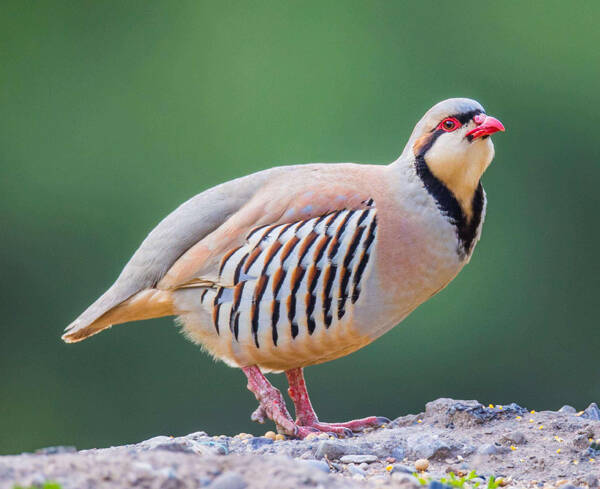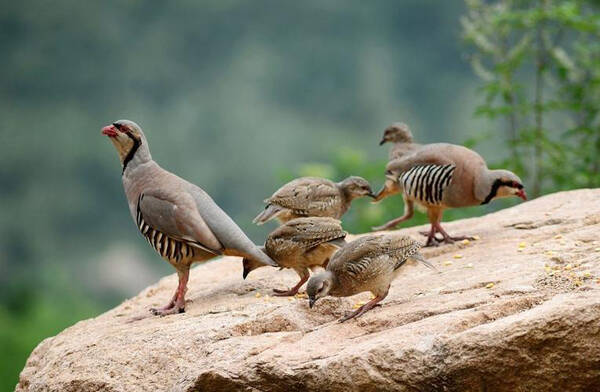Alectoris chukar
IUCN
LCBasic Information
Scientific classification
- name:Alectoris chukar
- Scientific Name:Alectoris chukar,Chuckar,Chukar,Chukar Partridge
- Outline:Landfowl
- Family:Gallinariformes P.family Grouse
Vital signs
- length:27-37cm
- Weight:440-580g
- lifetime:No textual research information is available
Feature
Prominent black and maroon spots on both sides
Distribution and Habitat
Place of origin: Afghanistan, Armenia, Azerbaijan, Bulgaria, China, Cyprus, Egypt, Georgia, Greece, India, Iran (Islamic Republic of), Iraq, Israel, Jordan, Kazakhstan, Kyrgyzstan, Lebanon, Mongolia, Nepal, Oman, Pakistan, Palestine, Russian Federation, Saudi Arabia, Syrian Arab Republic, Tajikistan, Turkey, Turkmenistan, Ukraine, United Arab Emirates, Uzbekistan.
Introduced in: Bahrain, Canada, France, Germany, Italy, Macedonia, New Zealand, Norway, Portugal, St. Helena, Ascension and Tristan da Cunha, South Africa, Spain, United States (Hawaii).
It inhabits rocky slopes and sandy slopes in the hilly areas of low mountains, and is rarely seen in open fields, let alone in forest areas. Prefers to live on barren arid and semi-arid hillsides with low vegetation cover and occasionally trees and very low shrubs. At lower elevations, it can be found on rocky hillsides with shrubs and bushes suitable for dry conditions, in vineyards, olive groves and farmland.
Appearance
The head of the rooster is reddish-brown from the top to the back of the neck, the forehead is gray, and the two sides of the head are also stained with light gray, and the eyebrows are white and brown. There is a wide black band from the frontal base through the eyes to the back pillow, and then down the side of the neck, across the lower throat, forming a complete black circle around the throat; Yellowish-white eyes, cheeks and throat, yellowish-brown to dark brown, depending on subspecies; Chestnut-brown ear, grey-olive on both sides of the nape, purple-brown or brown-red upper back, extending to the inner shoulder and thorax; Outer shoulder feathers cinnamon, middle pinna blue-gray; Lower back, waist, upper tail cover and central tail feathers gray olive; The outer tail feathers are chestnut brown, the upper wing feathers and the inner fly feathers are similar to the upper back, the primary fly feathers are light dark brown, the feather shaft is light brown, and the outer webs have
Details
Alectoris chukar (Chuckar, Chukar, Chukar Partridge) is a medium-sized pheasant with 14 subspecies.

Grouper is a resident bird. Active during the day, the sex likes to cluster, sometimes during the day to the farmland near the hillside to forage, after the shock straight to the mountain quickly run. Emergency also fly, flying ability is strong and fast, but fly not far and fall into the grass or brush. Early in the morning and at dusk, the rooster often stands on the bare rock or high ground and calls loudly, like "quack quack quack..." Or "crunch, crunch" sound, so the local people call it "Quack chicken". The first tweet is slow, then gradually picks up speed and repeats many times.
It feeds mainly on buds, tender leaves, berries, seeds, mosses, lichens, and insects of herbs and shrubs, and often feeds on grains from nearby farmlands.
The breeding season is from late April to mid-June. Estrus began in mid-to-late April, during which the day began to sing at dawn, and occasionally there was a fight between male chicks. It is usually nested in the scrub and grass at rock piles or hillside, but also in the scrub and grass at the base of hanging rock, under the SLATE on the side of a mountain, or between mountains and gullies. The nest is very simple and very hidden, mainly a pit in the ground, which is filled with dead grass. Each clutch lays 7-17 eggs, occasionally as many as 20. Eggs began to lay in early May, 1 a day, after the female bird finished laying eggs, often quietly flew out of the mountain gully, turned to the male bird near, and then with the male chicken relative "quack" call non-stop. Eggs brown white or yellow skin, with dark red spots varying in size, the size of the egg is 38.6-42.5 mm ×28.3-31 mm, the average 39.5 mm ×30.6 mm, weight 19-20 grams. Young birds have sex early and can follow their parents soon after hatching.

On September 30, 2020, the State Forestry and Grass Administration issued the Notice on the Scope of Classification Management of fasting wild Animals on its official website, and for 45 kinds of wild animals such as stone chickens, the Notice clearly requires that the relevant farmers should be actively guided to stop breeding activities before the end of December 2020, and complete the disposal work in accordance with relevant regulations. If it is really necessary to retain an appropriate amount of seed sources for non-edible purposes such as scientific research, the feasibility of the work program should be fully demonstrated and the relevant procedures should be strictly implemented.
The global population was estimated at 2,000,000 in 2004. In Europe, the breeding population is estimated at 488,000-1,680,000 pairs, equivalent to 975,000-3,370,000 mature individuals (BirdLife International 2015). Europe accounts for 10% of the global range, so the revised estimate of global species size is an average of 9,000,000 to 34,000,000 mature individuals, but further validation of this estimate is required. The number in China is estimated at 10,000-100,000 pairs (2009). In Europe, species numbers are estimated to have declined at a rate of nearly 30% in 11.7 years (three generations) (BirdLife International 2015). In Lebanon, the species is considered to be in local decline. Elsewhere, numbers are suspected to be stable or increasing locally (McGowan and Kirwan 2016).
Listed on the International Union for Conservation of Nature Red List of Threatened Species (IUCN) 2018 ver 3.1 - Not Threatened (LC).
Protect wild animals and eliminate wild meat.
Maintaining ecological balance is everyone's responsibility!








